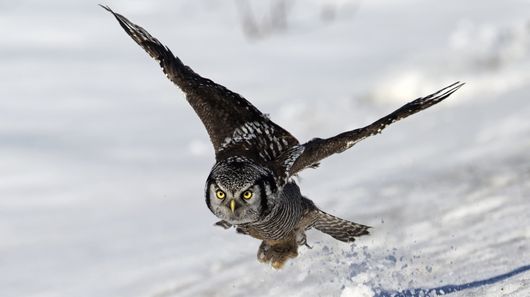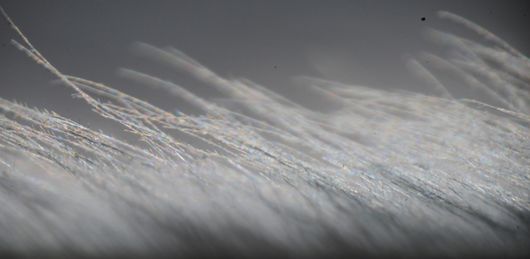
Researchers have mimicked the structure of owl wings, which enables them to fly almost silently (Credit: Shutterstock)
Owls are exceptional predators. In addition to their impressive vision and hearing capabilities, they are also able to fly almost silently. This stealthy flight is thanks to the structure of their wings, which researchers have analyzed and mimicked to develop a prototype coating that they claim could significantly reduce the noise generated by wind turbines, computer fans and airplanes.
Using fine detail microscopy, the researchers from the University of Cambridge in the US and Virginia Tech, Lehigh University and Florida Atlantic University in the US examined owl feathers in fine detail, revealing a downy covering that they say resembles a forest canopy when viewed from above. They also saw a flexible comb of evenly-spaced bristles along the wing's leading edge, while the trailing edge shad a porous and elastic fringe.
"No other bird has this sort of intricate wing structure," said Professor Nigel Peake of Cambridge’s Department of Applied Mathematics and Theoretical Physics, who led the research. "Much of the noise caused by a wing – whether it’s attached to a bird, a plane or a fan – originates at the trailing edge where the air passing over the wing surface is turbulent. The structure of an owl’s wing serves to reduce noise by smoothing the passage of air as it passes over the wing – scattering the sound so their prey can’t hear them coming."
Early attempts to replicate this structure included covering a blade with a wedding veil-like material, which, despite the open structure of the material, reduced the roughness of the underlying surface and cut the surface noise by up to 30 dB.Realizing that applying a wedding veil to a turbine or airplane isn't feasible, the team 3D printed a prototype made of plastic and tested it on a full-sized segment of a wind turbine blade. Subjecting the blade to wind tunnel tests, the researchers saw a reduction in noise of 10 dB. Importantly, they reported no appreciable impact on aerodynamics.
The team is now planning to test the coating on a functioning wind turbine, and say that it could allow such turbines to spin faster and generate more electricity than they do currently. This is because wind turbines are currently braked to minimize noise, and letting them spin faster could mean several extra megawatts worth of electricity for an average sized wind farm.
In addition to quieter wind turbines, the researchers say the coating could also find applications on a range of different types of wings and blades – however, the coating still needs to be optimized and incorporating it into airplane wings would be far more complicated than a wind turbine blade.
The team will present the results of their study ay the American Institute of Aeronautics and Astronautics (AIAA) Aeroacoustics Conference in Dallas today.
Source: University of Cambridge
Copyright © Gizmag 2003 - 2015
http://www.gizmag.com/owl-inspired-surface-reduce-wind-turbine-noise/38123
